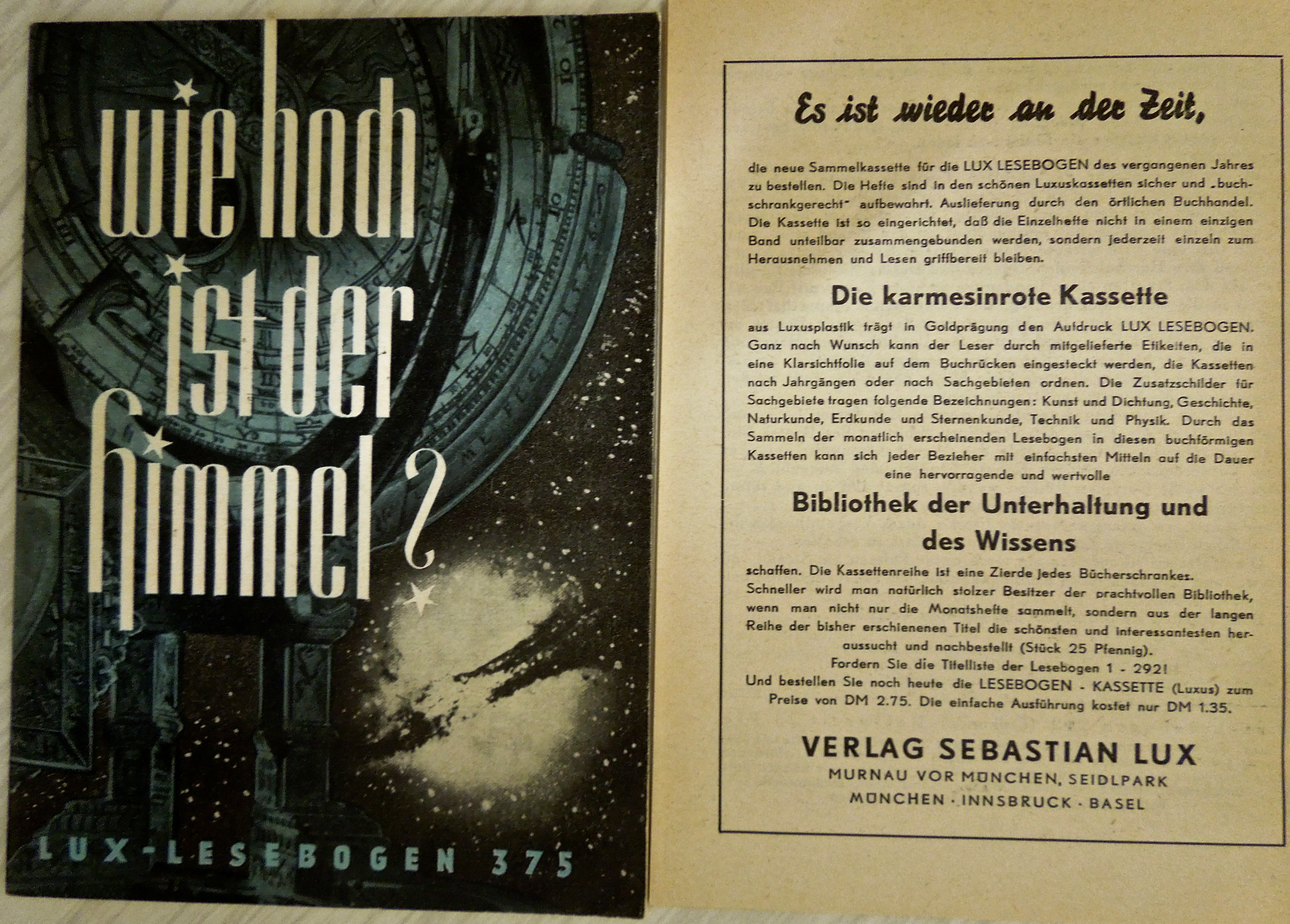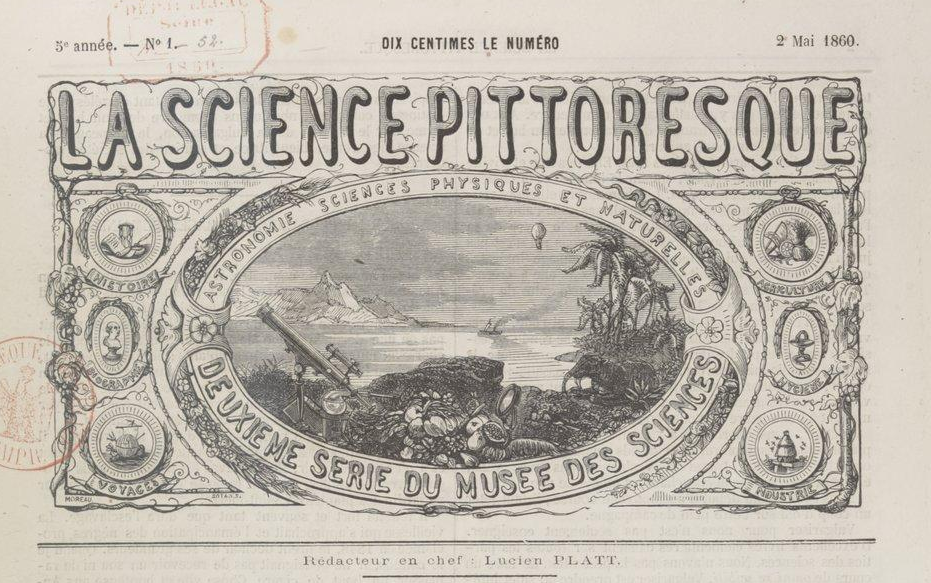
October 24, 2014, by Brigitte Nerlich
Making science picturesque
 I was idly browsing io9 the other day and read a fascinating article on comets in the history of art. This would be a nice topic for another blog post… but that’s not what this post is about. When looking at these delightful pictures, my eyes fell on “an engraving from Le Magasin Pittoresque, a French magazine published between 1833 and 1938”. Aaah, I reminisced, I once owned a copy of this popular science magazine when I was researching the illustrations in Jules Verne’s work for a little student dissertation I wrote in the 1980s. This in turn set me thinking about pictures, publics and the popularisation of science.
I was idly browsing io9 the other day and read a fascinating article on comets in the history of art. This would be a nice topic for another blog post… but that’s not what this post is about. When looking at these delightful pictures, my eyes fell on “an engraving from Le Magasin Pittoresque, a French magazine published between 1833 and 1938”. Aaah, I reminisced, I once owned a copy of this popular science magazine when I was researching the illustrations in Jules Verne’s work for a little student dissertation I wrote in the 1980s. This in turn set me thinking about pictures, publics and the popularisation of science.
In the following I’ll first say a few words about the Magasin Pittoresque, then something about digitisation and accessibility and then about education and entertainment with ‘the picturesque’ as a vehicle for both. I’ll end by saying something personal about the image I have used to illustrate this post. The red thread running through this post is the topic of ‘making science public’, in the 19th century through magazines, in the 20th century through the digital medium, a medium that also allows us to access images of science seen almost two centuries ago by an emerging science public. That is to say, we can now see how public engagement with science unfolded in these popular magazines (by digitally leafing through them) and, if one had time, compare modes of public engagement then and now (I’ll leave that to others).
The Magasin Pittoresque
From the end of the 18th century onwards, in the wake of the enlightenment (including the Encyclopédie) and the emergence of modern science, many popular science magazines began to appear, first it seems in the UK, but then also in France and all over the Western world. One of the earliest French science magazines was the Magazin Encylopédique ou Journal des Sciences, des Lettres et des Arts. Its aims were set out in the first volume of 1792, namely to provide readers interested in the arts and the sciences with something other than just political news. And it wanted to do this in an agreeable, amusing and instructive manner. This goal, to educate while entertaining, was also the aim of many magazines that followed, well into the mid-twentieth century (see image). These periodicals “played a far greater role than books in shaping [19th-century publics’] understanding of new discoveries and theories in science, technology and medicine”.
The Magasin pittoresque was founded by Édouard Charton in January 1833. He was heavily engaged in politics, education and publishing and had “faith in … the emancipation of people through education; respect for human dignity, constant fight for the dissemination of knowledge and political action in favor of liberal and republican ideas” (wiki). As part of this emancipatory dissemination of knowledge, Charton wanted to publish an encyclopaedia mainly based on pictures. The result was the Magasin Pittoresque, which ended up covering new discoveries in ethics, history, art, archaeology, science, industry and travel for a century (for more information see Aurench’s 2002 book, Edouard Charton et l’invention du Magasin pittoresque).
Science, the picturesque and the public
There were other magazines similar to this one but not as successful, such as the Encyclopédie pittoresque, La France pittoresque, the short-lived La Science Pittoresque, the more successful La Science Illustrée, or even L’Univers pittoresque: Histoire et description de tous les peuples (and more).
 Pittoresque was certainly a word very much in vogue at the time. Its meaning was linked to pictures and paintings but also to pleasure, that is to pleasing images, images that attract the attention of the reader and contribute to educating while entertaining. A plethora of the Magasin’s picturesque pictures can be seen here on Google images.
Pittoresque was certainly a word very much in vogue at the time. Its meaning was linked to pictures and paintings but also to pleasure, that is to pleasing images, images that attract the attention of the reader and contribute to educating while entertaining. A plethora of the Magasin’s picturesque pictures can be seen here on Google images.
The ‘picturesque’ in this sense bridges art and science, as well the local and the global, and of course science and ‘the public’. These picture-focused magazines emerged alongside public lectures about science and, like them made science ‘spectacular’. They responded to and created a new public attentive to and interested in science (and the arts) in all its forms, especially when linked to explorations and adventures. Education and entertainment were seen as two sides of the same coin. This was also the ideology behind publications like the explicitly titled Magasin d’Education et the Récréation, in which Jules Verne first published his tales of science, fiction and natural history. Édouard Charton also published Le Tour du Monde, a magazine with a title that foreshadows Verne’s famous novel Le tour de monde en quatre-vingts jour (1873)!
Overall, Charton’s aim was to ‘combat ignorance’ and in so doing alleviate social injustice. Le Magasin Pittoresque seems to have fulfilled this mission quite successfully. In its second year of publication it was bought by 100,000 people! And it only ceased to fill deficits in knowledge in 1938, just before the second world war. The engravings and later photos that delighted readers for so long are picturesque, but not just picturesque. They are ‘more than pretty pictures‘. They incite wonder, awe and delight, just like images of nature, the cosmos and the invisible world around and within us still do today in print, on television and in the digital world. Most of all they might enable learning and understanding.
Digitising the picturesque
We citizens of the 21st century now have these old periodicals at our fingertips and can see from our desk at home or at work what 19th-century publics were reading and what images they saw and enjoyed. And, of course, somebody out there has probably already undertaken a detailed study of how public images of science were shaped by these public images of science!
When googling more, I found that the old Bibliothèque Nationale that I remember so fondly and dustily from the 1980s is now a gleaming haven of digitisation and has a digital branch called ‘Gallica’, open to everybody to browse – it makes science and the history of science public. In it we find a digitised version of some of the issues of the Magasin Pittoresque. Another and even more enjoyable way to see what our ancestors saw and to see science unfolding through their eyes, is to ‘leaf’ through the Magasin on this Open Library site! You can savour the engravings which range from architecture to anacondas! This makes not only old science public, but old publics public too!
Education, entertainment and public engagement with science
In my last post I talked about appreciating and respecting various depths of knowledge associated with scientific concepts and issues. I also wrote about ‘paddling in the shallow end of knowledge’. I believe the ‘picturesque’, as used in science magazines like the Magasin pittoresque enabled millions of readers to paddle in the shallow end of knowledge about science, the arts and the world. This is not a bad thing, despite outcries of ‘deficit model’. Without these science communication and/or public engagement activities many people would not even find their way to the swimming pool and the deeper ends of knowledge. ‘Education and entertainment’, with the picturesque as a way of attracting readers or nowadays television or digital media viewers, is an enduring combination that caters to what Alison Woollard called “people’s hunger for knowledge, and their excitement when they make a new connection”.
On a personal note
The image I have chosen for this post is a photo of a Lux Lesebogen (Bibliothek der Unterhaltung und des Wissens – Library of Entertainment and Knowledge). This popular German science magazine began to appear shortly after the second world war in order to ‘educate and entertain’ readers about both the Natur– and the Geisteswissenschaften. My father, then a teenager, saved every penny to collect, read and later draw inspiration for teaching youngsters from these small booklets. He was not alone. When these Lesebogen ceased publication in 1964 25 million had been sold and they contributed immensely to filling a scientific and cultural knowledge vacuum left during the war.
For more info on science, images and visualisation, see here.

Thank you for this interesting post – especially the impressive circulation figures for the magazines your mention. Just wanted to mention four points :
i) Whilst I could not afford many magazines as a kid, I was encouraged to join local libraries – and used them to the max! They were an incredible learning opportunity and one that I am very grateful for
ii) I wonder how other cultures (e.g. Africa, Middle East, Japan, China) compare to the UK and Western Europe in terms of availability of popular science magazines and local lending libraries – do you have any idea as to who might be able to provide information on this?
iii) I wonder, Brigitte, how many of your academic colleagues might say that popular science magazine / availablility of libraries was a factor in inspiring them to take the directions that they have….
iv) Where can I find a pdf of the “Technologies of Scientific Visualization” paper?
Lets start at the bottom. Send me an email and I’ll send you the papers. They will be open access in about 6 months time but are unfortunately not yet. I think there are many ‘roads’ to science I suppose, but I do think popular magazines (games, sites like io9 or Gizmodo etc.) play an important role. Ironically though, despite reading my fathers ‘science’ magazines and books, going fossil hunting with him and all that, I studied humanities subjects in the end, only to return to science 30 years later! Now the topic of science communication/popularisation etc in China etc. is really interesting and there is not a lot of work done on this, I think – but here is something on East Asia: http://books.google.co.uk/books?id=Oe9mYBYQjm4C&pg=PA237&lpg=PA237&dq=science+communication+in+asia&source=bl&ots=L6G6xe8-Pa&sig=vtiTVr9p3DuqnXIIzp-6nrBR8_8&hl=en&sa=X&ei=jERLVOeXJ-TB7AaRgIGQAw&ved=0CEwQ6AEwBg#v=onepage&q=science%20communication%20in%20asia&f=false
Interesting link, thanks!
[…] have a bit more information about who illustrated Verne’s work. Most of the novels were originally illustrated with “woodblock engravings, […]